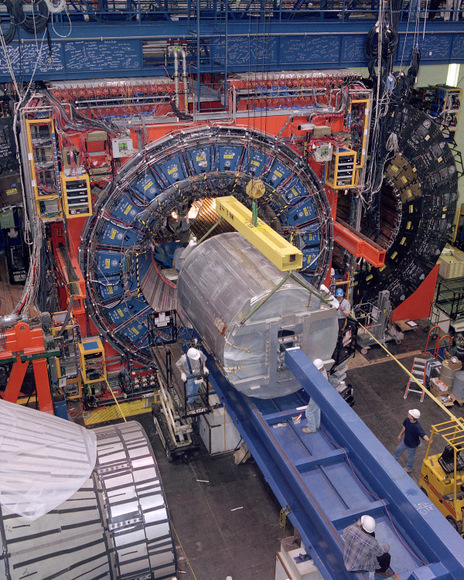New Particle Throws Monkeywrench in Particle Physics
The hits just keep on coming from Department of Energy's Fermi
National Accelerator Laboratory. So far this month, the lab has
announced the discovery of a rare
single top quark, and then narrowed
the gap — twice,
actually — for
the mass of the elusive Higgs Boson particle, or "God particle,"
thought to give all other particles their mass.
Now, scientists have detected a new, completely untheorized
particle that challenges what physicists thought they knew about
how quarks combine to form matter. They're calling it Y(4140),
reflecting its measured mass of 4140 Mega-electron volts.

The CDF detector, about the size of a 3-story house, weighs
about 6,000 tons. Its subsystems record the "debris" emerging
from high-energy proton-antiproton collisions. Credit: Fermilab
“It must be trying to tell us something,” said Jacobo Konigsberg
of the University of Florida, a spokesman for Fermilab's
collider detector team. “So far, we’re not sure what that is,
but rest assured we’ll keep on listening.”

The Standard Model of elementary particles and forces includes
six quarks, which bind together to form composite particles.
Credit: Fermilab
Matter as we know it comprises building blocks called quarks.
Quarks fit together in various well-established ways to build
other particles: mesons, made of a quark-antiquark pair, and
baryons, made of three quarks.
But recently, electron-positron colliders at Stanford's SLAC
National Accelerator Laboratory and the Japanese laboratory KEK
have revealed examples of composite quark structures — named X and Y particles
— that are not the usual mesons and baryons. And now,
the Collider Detector at Fermilab (CDF) collaboration has found
evidence for the Y(4140) particle.
The Y(4140) particle decays into a pair of other particles, the
J/psi and the phi, suggesting to physicists that it might be a
composition of charm and anticharm quarks. However, the
characteristics of this decay do not fit the conventional
expectations for such a make-up. Other possible interpretations
beyond a simple quark-antiquark structure are hybrid particles
that also contain gluons, or even four-quark combinations.
The Fermilab scientists observed Y(4140) particles in the decay
of a much more commonly produced particle containing a bottom
quark, called the B+ meson. Sifting through trillions of
proton-antiproton collisions from Fermilab’s Tevatron, they
identified a small sampling of B+ mesons that decayed in an
unexpected pattern. Further analysis showed that the B+ mesons
were decaying into Y(4140).
The Y(4140) particle is the newest member of a family of
particles of similar unusual characteristics observed in the
last several years by experimenters at Fermilab’s Tevatron as
well as at KEK and the SLAC lab, which operates at Stanford
through a partnership with the U.S. Department of Energy.
"We congratulate CDF on the first evidence for a new unexpected
Y state that decays to J/psi and phi,” said Japanese physicist
Masanori Yamauchi, a KEK spokesperson. “This state may be
related to the Y(3940) state discovered by Belle and might be
another example of an exotic hadron containing charm quarks. We
will try to confirm this state in our own Belle data."
Theoretical physicists are trying to decode the true nature of
these exotic combinations of quarks that fall outside our
current understanding of mesons and baryons. Meanwhile,
experimentalists happily continue to search for more such
particles.
“We’re building upon our knowledge piece by piece,” said
Fermilab spokesperson Rob Roser, “and with enough pieces, we’ll
understand how this puzzle fits together.”
The Y(4140) observation is the subject of an article submitted
by CDF to Physical
Review Letters this
week. Besides announcing Y(4140), the CDF experiment
collaboration is presenting more than 40 new results at the
Moriond Conference on Quantum Chromodynamics in Europe this
week, including the discovery of electroweak top-quark
production and a new limit on the Higgs boson, in concert with
experimenters from Fermilab’s DZero collaboration.
Source: Fermilab
Related stories on Universe Today


